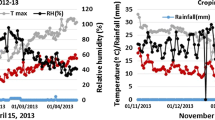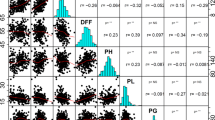Abstract
Genetic biofortification is a cost-effective strategy to address iron (Fe) and zinc (Zn) deficiencies prevalent worldwide. Being a rich and cheap protein source, chickpea, a food legume grown and consumed across the globe, is a good target for biofortification. Nineteen popular commercial cultivars of India were analysed for Fe and Zn content at four locations representing different agro-climatic zones to study the genotypic and genotype × environment interactions on Fe and Zn. Distribution of phytic acid (PA), an important anti-nutrient that chelates and reduces the mineral bioavailability, was also analysed. Influence of other agronomic traits like days to flowering, plant height and 100 seed weight on Fe and Zn content was also studied. All the traits showed significant G and G × E interactions; however, the magnitude of variance of GXE was lesser than that of G alone. Genotype + genotype-by-environment and genotype-by-trait biplots were used to assess the relations between different environments, genotypes and traits. Iron and zinc content showed positive correlation between them indicating a possibility of their co-selection in breeding. A negative correlation between Zn and PA was observed. However, there was very low variability for PA content in the cultivars under study, indicating that moderate PA is naturally selected in these cultivars during breeding. Despite significant GXE interactions, cultivars with high Fe (> 70 µg/g) and Zn content (> 40 µg/g) at three out of four test locations were identified. Such genotypes will be useful in breeding programs for enhancing mineral micronutrient content and understanding the molecular mechanisms governing their differential uptake.




Similar content being viewed by others
References
Alajaji SA, El-Adawy TA (2006) Nutritional composition of chickpea (Cicer arietinum L.) as affected by microwave cooking and other traditional cooking methods. J Food Compost Anal 19:806–812. https://doi.org/10.1016/j.jfca.2006.03.015
Amarakoon D, Thavarajah D, McPhee K, Thavarajah P (2012) Iron-, zinc-, and magnesium-rich field peas (Pisum sativum L.) with naturally low phytic acid: a potential solution to global micronutrient. J Food Compost Anal 27:8–13. https://doi.org/10.1016/j.jfca.2012.05.007
Badigannavar A, Girish G, Ramachandran V, Ganapathi TR (2016) Genotypic variation for seed protein and mineral content among post-rainy season- grown sorghum genotypes. Crop J 4:61–67. https://doi.org/10.1016/j.cj.2015.07.002
Bueckert RA, Thavarajah D, Thavarajah P, Pritchard J (2011) Phytic acid and mineral micronutrients in field- grown chickpea (Cicer arietinum L.) cultivars from western Canada. Eur Food Res Technol 233:203–212
Diapari M, Sindhu A, Bett K, Deokar A, Warkentin TD, Tar’an B (2014) Genetic diversity and association mapping of iron and zinc concentrations in chickpea (Cicer arietinum L.). Genome 57:459–468
Engle-Stone R, Yeung A, Welch RM, Glahn RP (2005) Meat and ascorbic acid can promote Fe availability from Fe-phytate but not from Fe-tannic acid complexes. J Agric Food Chem 53:10276–10284
Food and Agriculture Organization (FAO) (2017) FAO-STAT Statistical Database of the United Nation Food and Agriculture Organization (FAO) Statistical Division. Rome. http://www.fao.org/faostat/en/#data/QC. Accessed 11 Feb 2020
Frutos E, Galindo MP, Leiva V (2014) An interactive biplot implementation in R for modelling genotype-by-environment interaction. Stoch Envrion Res Risk Assess 28:1629–1641
Guerinot ML (2000) The ZIP family of metal transporters. Biochim Biophys Acta 1465:190–198
Haas JD, Luna SV, Lung’aho MG, Ngabo F, Wenger M, Murray-Kolb LE, Beebe S, Gahutu JB, Egli IM (2017) Consuming iron biofortified beans significantly improved iron status in Rwandan women after 18 weeks. J Nutr 146:1586–1592
Hu Y, Cheng Z, Heller LI, Krasnoff SB, Glahn RP, Welch RM (2006) Kaempferol in red and pinto bean seeds (Phaseolus vulgaris L.) coats inhibits bioavailability using an in vitro digestion/human CaCO-2 cell model. J Agric Food Chem 54:9254–9261
Joshi-Saha A, Reddy KS (2015) Repeat length variation in 5′UTR of myo-inositol monophosphatase gene is related to phytic acid content and contributes to drought tolerance in chickpea (Cicer arietinum L.). J Exp Bot 66:5683–5690
Joshi-Saha A, Mehzabin P, Reddy KS, Ramachandran V (2018) Effect of seasonal variation on micronutrient content in chickpea (Cicer arietinum L.) and identification of accessions having high iron and zinc. J Food Legumes 3:1–4
Kanatti A, Rai KN, Radhika K, Govindaraj M, Sahrawat KL, Rao AS (2014) Grain iron and zinc density in pearl millet: combining ability, heterosis and association with grain yield and grain size. Springer Plus 3:763
Ma G, Li Y, Jin Y, Zhai F, Kok FJ, Yang X (2007) Phytate intake and molar ratios of phytate to zinc, iron and calcium in the diets of people in China. Eur J Clin Nutr 61:368–374
Magallanes-López AM, Hernandez-Espinosa N, Velu G et al (2017) Variability in iron, zinc and phytic acid content in a worldwide collection of commercial durum wheat cultivars and the effect of reduced irrigation on these traits. Food Chem 237:499–505
Mallikarjuna MG, Thirunavukkarasu N, Hossain F, Bhat JS et al (2015) Stability performance of inductively coupled plasma mass spectrometry-phenotyped kernel minerals concentration and grain yield in maize in different agro-climatic zones. PLoS ONE 10:e0139067. https://doi.org/10.1371/journal.pone.0139067
Muehlbauer FJ, Sarker A (2017) Economic importance of chickpea: production, value and world trade. In: Varshney RK, Thudi M, Muehlbauer FJ (eds) The chickpea genome, compendium of plant genomes. Springer, Berlin, pp 5–12
Muthayya S, Rah JH, Sugimoto JD, Roos FF, Kraemer K, Black RE (2013) The global hidden hunger indices and maps: an advocacy tool for action. PLoS ONE 8:e67860
Phuke RM, Kotla A, Kommineni R, Jabeen F et al (2017) Genetic variability, genotype × environment interaction, correlation, and GGE biplot analysis for grain iron and zinc concentration and other agronomic traits in RIL population of Sorghum (Sorghum bicolour L. Moench). Front Plant Sci 8:172
Putto W, Patanothai A, Jogloy S, Hoogenboom G (2008) Determination of mega-environments for peanut breeding using the CSM-CROPGRO- peanut model. Crop Sci 48:973–982
Rakshit S, Ganapathy KN, Gomashe SS, Rathore A et al (2012) GGE biplot analysis to evaluate genotype, environment and their interactions in sorghum multi-location data. Euphytica 185:465–479
Saltzman A, Birol E, Bouis HE, Boy E, De Moura FF, Islam Y, Pfeiffer WH (2013) Biofortification: progress toward a more nourishing future. Glob food Secur 2:9–17. https://doi.org/10.1016/j.gfs.2012.12.003
Swamy BPM, Rahman MA, Inabangan-Asilo MA et al (2016) Advances in breeding for high grain zinc in rice. Rice 9:49
Tan GZH, Das Bhowmik SS, Hoang TML et al (2018) Investigation of baseline iron levels in Australian chickpea and evaluation of a transgenic biofortification approach. Front Plant Sci 9:88
Thavarajah P, Thavarajah D, Vandenberg A (2009) Low phytic acid lentils (Lens culinaris L.): a potential solution for increased micronutrient availability. J Agric Food Chem 57:9044–9049
Upadhyaya HD, Bajaj D, Das S et al (2016) Genetic dissection of seed-iron and zinc concentrations in chickpea. Sci Rep 6:24050
Vandemark GJ, Grusak MA, McGee RJ (2018) Mineral concentrations of chickpea and lentil cultivars and breeding lines grown in the U.S. Pacific Northwest. Crop J 6:253–262. https://doi.org/10.1016/j.cj.2017.12.003
Velu G, Ortiz-Monasterio I, Cakmak I, Hao Y, Singh RP (2014) Biofortification strategies to increase grain iron and zinc concentrations in wheat. J Cereal Sci 59:365–372. https://doi.org/10.1016/j.jcs.2013.09.001
Yan W, Rajcan IR (2002) Biplot analysis of test sites and trait relations of soybean in Ontario. Can J Plant Sci 42:11–20
Yan W, Tinker NA (2006) Biplot analysis of MET data: principals and applications. Can J Plant Sci 86:623–645. https://doi.org/10.4141/P05-169
Acknowledgements
Authors thank Mr. P.N. Thokal for help in sample preparation for atomic absorption spectroscopy.
Funding
This research received no specific grant from any funding agency, commercial or not-for-profit sectors.
Author information
Authors and Affiliations
Contributions
GM prepared samples and estimated Fe, Zn and PA content. DS did the spectroscopic analysis. GPD, AKS, VJ, MSP collected the data for IIPR, NRC, Nandyal and Junagadh, respectively. AJS and GPD designed the study. AJS compiled and analysed the data statistically. AKS did biplot analysis. AJS, KSR, GPD and PMG wrote the manuscript.
Corresponding authors
Ethics declarations
Conflict of interest
The authors declare there are no conflicts of interest.
Ethics approval
Not applicable.
Additional information
Publisher's Note
Springer Nature remains neutral with regard to jurisdictional claims in published maps and institutional affiliations.
Electronic supplementary material
Below is the link to the electronic supplementary material.
Rights and permissions
About this article
Cite this article
Misra, G., Joshi-Saha, A., Salaskar, D. et al. Baseline status and effect of genotype, environment and genotype × environment interactions on iron and zinc content in Indian chickpeas (Cicer arietinum L.). Euphytica 216, 137 (2020). https://doi.org/10.1007/s10681-020-02673-z
Received:
Accepted:
Published:
DOI: https://doi.org/10.1007/s10681-020-02673-z




